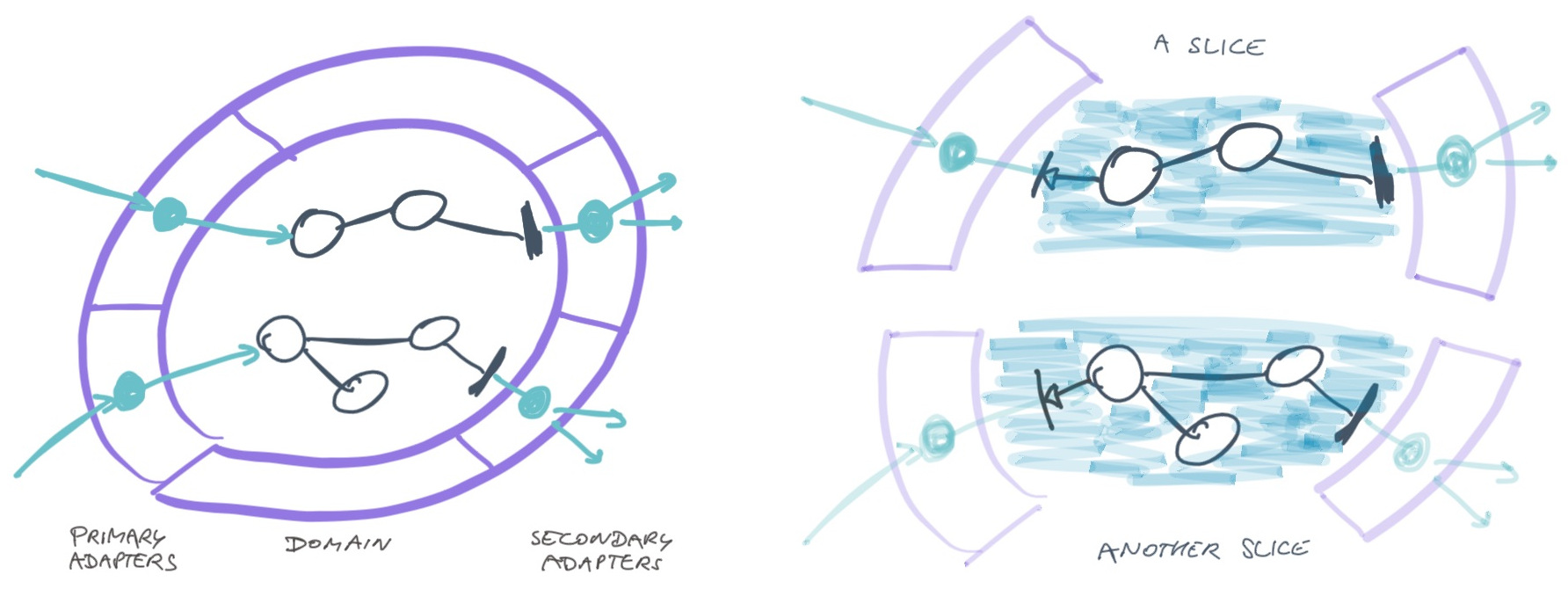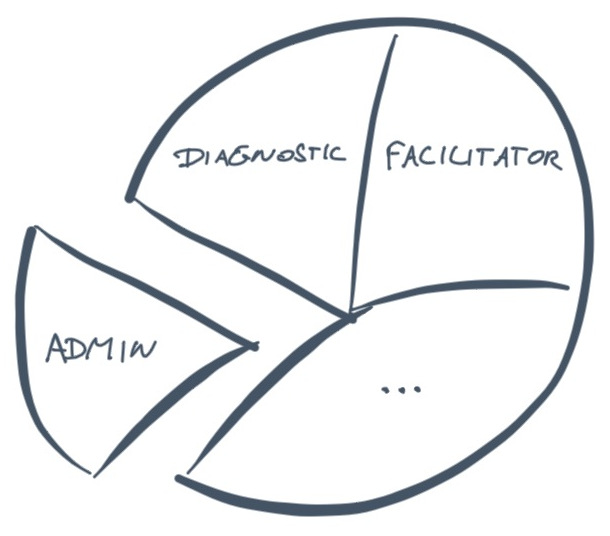You are happily applying the Hexagonal Architecture pattern. You have hidden the unpredictable outside world behind ports and adapters, so you can speak your domain language. Awesome! But now your domain model grows as well. How do you keep that understandable? Imagine the inside of your hexagon was a cake. How would you slice your domain?

In previous posts, we introduced Hexagonal Architecture. We demonstrated how we apply it, both in front-end and back-end components. We showed how it helps us to trade off the many design decisions we make when developing front-end and back-end code. In this post, we describe our approach how we structure the inside of a hexagon, the ‘domain’. We present it as a proto pattern “Slice the domain as cake”. Slicing lets us evolve components without losing our way.
Context
When a component grows, it gets more complex and unwieldy. Applying the Hexagonal Architecture pattern helps to separate adapters and mapping from the domain logic. The domain logic itself however will grow complex and unwieldy sooner or later.
We could split up the component to tackle complexity, but it pays to focus on good modularity first. Otherwise we’d end up with distributed complexity and we’re worse off.
How can we structure the domain code in a way that keeps it modular, understandable and maintainable? How do we prevent ending up with my routing code, UI components and other adapters knowing everything in the domain? When everything is coupled to everything,it is hard to see the impact a change would have.
Forces
- Small components grow up. When they grow, they contain more concerns and become unwieldy.
- This is not restricted to back-end components only. It could be a front-end, a back-end, a database, or sensors and actuators in an embedded system. Software is only limited by our imagination.
- Dependencies between different objects, functions, systems become unclear.
- You know that not everything depends on everything, but this is hard to see from the code because everything is exposed to everything.
- Exposing primary adapters to all domain code details creates a strong dependency, making the adapters highly sensitive to change. It becomes unclear what the real dependencies are.
Solution
A solution direction is to divide the core of the hexagon in slices that are based on the domain model. Each slice presents a Facade to the primary ports, e.g. UI components or HTTP REST routes. Each slice can depend on one or more secondary ports, e.g. a repository or messaging.

The responsibilities of a slice are:
- It acts as a Facade towards primary adapters; e.g. in a front-end component, it specifies/exposes what data a UI component can show and what actions it can trigger.
- It knows relevant repositories, so that it can handle side-effects - retrieving data, storing data, and it can handle any associated asynchronous behaviour.
- It delegates behaviour and (view) domain logic as much as possible to behaviourally rich domain objects.
- A slice can expose a set of related Command and Queries (Read Models).

An alternative way of describing this is to say that we structure a component not as a single hexagon, but as multiple sub-hexagons.
An example
In the Online Agile Fluency® Diagnostic application we have developed, we have a Vue.js based front-end component. It bundles different concerns: there is a part for facilitators to create diagnostic sessions, give participants access, and see aggregated results; there is a survey for participants, and an administrator interface for managing facilitator accounts.
We started out using Vuex. Vuex is highly opinionated about how to structure the logic and state management related to front end components, and provides guidance of What to Put Where. We found it to be highly integrated and coupled with our front end components, which made writing focused tests for the logic harder among other things.
So we decided to roll our own way of handling logic and state in plain
JavaScript. Inspired by how Vuex provides modularity through different
‘modules’, we created a number of ‘module’ objects, an AdminModule, a
DiagnosticModule and a FacilitatorModule.

The diagnostic-module slice provides data and actions regarding the diagnostic
session and the associated survey.
1
2
3
4
5
6
7
8
9
10
11
12
13
14
15
16
export class DiagnosticModule {
constructor (questionRepository, sessionJoiner, ...) {
this._questionRepository = questionRepository
this._sessionJoiner = sessionJoiner
...
}
get color () { ... }
get facilitator () { ... }
get questions () { ... }
join (sessionId, joiningId) { ... }
retrieveQuestions (sessionId, participantId) { ... }
updateAnswer (question, value) { ... }
...
}
A module is implemented by a plain JavaScript class. We explicitly inject any
dependencies, in this case two ports, the questionRepository that contains
questions and answers, and the sessionJoiner which handles correct joining of
a participant so that he/she will see the correct survey.
The module exposes properties to the UI components, like the color and the
facilitator’s name. It also exposes actions that can be initiated from the UI
components, like retrieveQuestions to start retrieving survey questions
asynchronously, join for a participant joining a session and updateAnswer
for changing an answer in the survey.
The module only exposes data and actions that are relevant to the UI components, the rest is private. UI components do not have access to repositories for instance.
Considerations
The DiagnosticModule class is quite a big slice of the cake: it does a lot, handling diagnostic sessions for facilitators and surveys for workshop participants. We could split it up into smaller slices.
How do we determine the size of a slice? If we have many small slices, it may get unwieldy. If a slice is large, we tend to group unrelated things that have different reasons to change. Here are some design heuristics for splitting a hexagon into slices:
- Organize around the Aggregates you have found in event storming or some other domain modelling technique; splitting up according to domains or bounded contexts will probably be too course grained.
- If you do user story mapping, you will have mapped out users’ activities and tasks; you could slice by user activity.
- Group around objects/functions working on the same data.
- Group data and actions related to specific user roles.
- Put data with different lifecycles in separate slices.
Naming the slices: we borrowed the ‘module’ term from Vuex. We could also have called it ‘DiagnosticSessionSlice’, or just ‘Diagnostics’ following the principle of not naming objects after the pattern applied. We’d rather not call them ‘service’ because this is already an overloaded term with little meaning of its own.
What to do with shared objects? We can put these in one or more shared folders or libraries on which different slices depend.
Wiring the component: you need to instantiate ‘slices’ and inject any secondary ports. In our Vue.js based component, this is done from the main function.
We could have split the front-end component into 3 separate front-ends based on our different users: the administrator part, the diagnostic session management part, and the survey part. The trade-off here is managing 3 simpler deployables that do have some overlapping code vs having a larger, more complicated code base. For us the latter was preferable.
Related work
These ideas have been inspired by work of others, to mention a few:
- Jimmy Bogard’s Vertical Slice architecture
- A domain-driven Vue.js Architecture
- Michel Weststrate, UI as an afterthought
- Alberto’s Brandolini’s Event Storming technique has also been influential in how we look at the domain.
Another source of inspiration were the fruitful discussions I had with software architects at RIGD-Loxia a number of years ago. We explored how to apply Hexagonal Architecture to the (sometimes quite complex) Railway Safety Engineering software they develop. The ‘slices of cake’ metaphor originates from there.
A current related development is micro-frontends. Micro-frontend have as upsides: independent evolution, scaling, support of multiple back-ends without tangling. Some downsides are: loss of type-safety, more complicated builds and ‘interesting’ choices in deployment.
The Slicing your Cake pattern is also related to the Micro Front-ends pattern. In a way, micro front-ends are cake slices taken to the extreme. Slice your front-end cake in modular parts will facilitate splitting it up in micro front-ends later.
Credits:
- Photo credits: Photo by Annie Spratt on Unsplash
- Thanks to Willem for reviewing and encouraging me to get this published.
